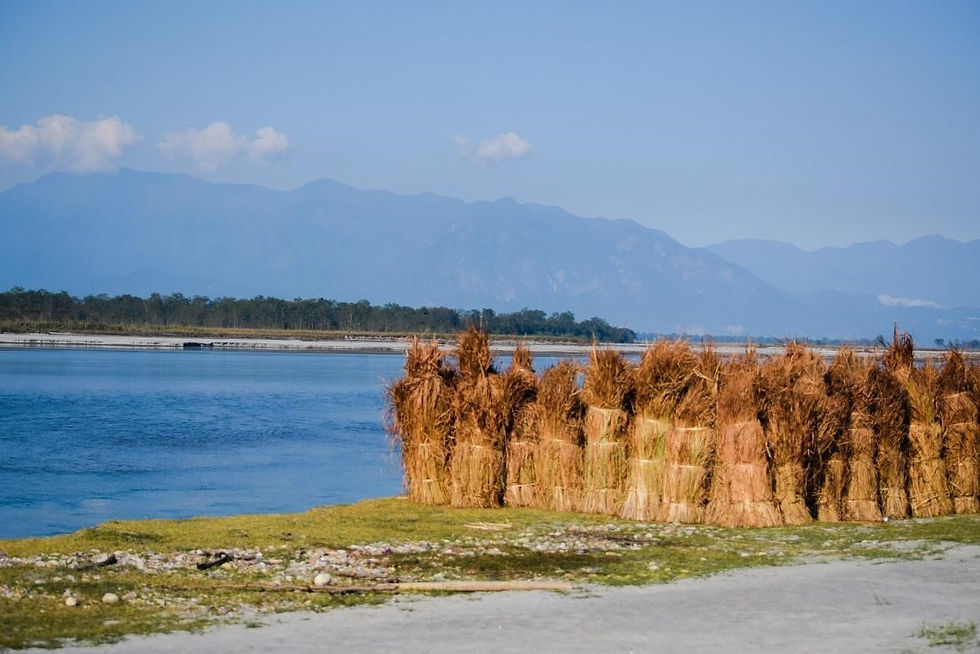What's that hiding in the grasses? Grassland bird's preferred habitat
- Ecology Research Explained

- May 11, 2021
- 4 min read
Nandana Chaudhuri
MSc dissertation
Pondicherry university (2017-2019)
Arunachal Pradesh, fondly known as the land of dawn-lit mountains, bestows a range of landscapes from snow-clad peaks to untouched semi-evergreen forests and river islands. Because of its rich vegetation and high rainfall, Arunachal Pradesh has among the highest biodiversity in India. In fact, new species are still regularly discovered from its forests!
For my dissertation, I decided to study one of the most threatened ecosystems found here: the grasslands. Grasslands in Arunachal Pradesh are among the few pockets of grasslands still surviving in India. They are present on the banks and islands of the River ‘Siang’. This system of river islands forms the Daying Ering Wildlife Sanctuary, located near the foothills of the Himalayas. These islands support certain bird species like Swamp Prinia, Black-breasted Parrotbill and Daurian Redstart which are not found anywhere else in the world! So, what is it about these grasslands that make them such suitable habitats? To understand this, I conducted a study from December 2018 to March 2019 as a part of my master's dissertation.

Grasslands on the river islands on Siang River in D’Ering WLS.

Map of Daying Ering Wildlife Sanctuary in Arunachal Pradesh, India.
I specifically looked at the habitat preference of three birds: Jerdon’s Babbler, Black-breasted Parrotbill and Indian Grassbird. All three species prefer only one kind of habitat- the grasslands!

Birds hiding in the grass:
Jerdon’s Babbler, Black-breasted Parrotbill and Indian Grassbird respectively
But why!?
The results of my study showed that grasslands around the Siang river have tall, thick grasses. Such tall, dense patches of grasses provide a perfect hiding place for the birds. In addition, these grasslands are approximately 500 m away from the forests. When grasslands are this far from the forests, they typically have fewer trees, which reduces the intrusion of forest birds into the grasslands. This helps the grassland species by reducing competition.
To collect the data required for understanding this, a typical day in the field would start at 6 a.m. To reach the islands, we had to cross the river every day using a small country boat. Then we'd walk around 1-2 km over the white, sandy beach to get to each patch of grasslands. This is not as simple as it sounds, as with each step on the apparently dry land, there was fear of sinking in the quicksand. We were safely guided through the quicksand by Oki Modi, an experienced fisherman belonging to the local Adi community.

Our commute to the land of hidden birds
The surveys were conducted by counting the number of birds present in each patch of the grassland. Although these birds prefer to remain hidden within the thick grasses, they are not so shy when it comes to songs and calls. In fact, they are quick to respond when they hear a familiar call. So, for my study, we used a 3 level approach to note down the presence of a bird in a particular grassland patch. First, we would try to spot birds using binoculars and through naked eyes. Second, we would carefully listen to their calls and identify the birds from calls. And third, we would play recordings of bird calls to lure the birds out of their hiding (under expert supervision, with due permissions from the forest department). This technique, known as call playback, can prove to be a very useful tool in the study of birds when used in moderation. However, it can be extremely stressful to the birds and is illegal if used without appropriate permissions. The grasses in these patches were studied too, and particulars like grass height, grass species and density of grasses were noted.
In my surveys spanning only 4 months, I recorded a total of 69 species of birds in just 28 sq. km of grasslands! Grasslands are not just a haven for bird diversity, but they also prove to be invaluable for the local tribal community who use them to make thatched roofs and as filling for making cushions.

Collection of grasses by locals for making thatched roofs and cushions.
Despite being so precious, grasslands all over the world are highly vulnerable as only a small portion is under legal protection. They are used extensively to graze cattle which does not allow much time for the grasses to revive themselves. Moreover, The forest department follows certain management practices like burning the grasses before monsoon to improve grass quality and yield. The charred soil absorbs more heat and the onset of monsoons allows the perfect soil moisture required for a better yield of grasses. But these practices need to be done under controlled conditions to make sure the animals depending on the grasslands are unharmed. In addition, due to lack of awareness, grasslands are wrongly but regularly termed as ‘waste lands’ and these days, people are keen on planting trees where they see such beautiful, natural grasslands.
Thus, unfortunately, grassland ecosystems are under much pressure due to human intervention and conversion to forestland. It is our responsibility to protect these grassland islands in Arunachal Pradesh, which support one of the last fragments of surviving grasslands in India. Who knows how many species are still hiding in these grasses just waiting to be discovered!
-------------------------------------- Contributed by Nandana Chaudhuri. This work was carried out by Nandana as part of her MSc thesis from Pondicherry University (2017-2019). -------------------------------




Comments